The first ΔiH1 and the second ΔiH ionization enthalpies in kJ mol–1 and the ΔegH electron gain enthalpy in kJ mol–1 of a few elements are given below:Which of the above elements is likely to be : a the least reactive element. b the most reactive metal. c the most reactive non-metal. d the least reactive non-metal. e the metal which can form a stable binary halide of the formula MX2 X=halogen. f the metal which can form a predominantly stable covalent halide of the formula MX X=halogen?
a Element V is likely to be the least reactive element. This is because it has the highest first ionization enthalpy ΔiH1 and a positive electron gain enthalpy ΔegH. b Element II is likely to be the most reactive metal as it has the lowest first ionization enthalpy ΔiH1 and a low negative electron gain enthalpy ΔegH. c Element III is likely to be the most reactive non–metal as it has a high first ionization enthalpy ΔiH1 and the highest negative electron gain enthalpy ΔegH. d Element V is likely to be the least reactive non–metal since it has a very high first ionization enthalpy ΔiH2 and a positive electron gain enthalpy ΔegH. e Element VI has a low negative electron gain enthalpy ΔegH. Thus it is a metal. Further it has the lowest second ionization enthalpy ΔiH2. Hence it can form a stable binary halide of the formula MX2X=halogen. f Element I has low first ionization energy and high second ionization energy. Therefore it can form a predominantly stable covalent halide of the formula MX X=halogen.
Related Solutions
The first and the second ionization enthalpies and the electron gain enthalpy of a few elements are given below :
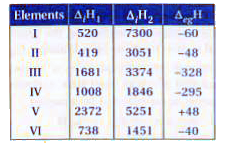
Which of the above elements is likely to be :
(a) the least reactive element.
(b) the most reactive metal.
(c) the most reactive non-metal.
(d) the least reactive non-metal.
(e) the metal which can form a stable binary halide of the formula , (X = halogen).
(f) the metal which can form a predominantly stable covalent halide of the formula MX (X = halogen)?
View SolutionThe first (DletaH) and second ionisation enthalipies (DeltaH_(2)) in kJmol^(-1) and the electron gain enthalpy (DeltaHg) in kJmol^(-1) of a few elements are given below: Which element is likely a) the least reactive element c) the most reactive non-metal b) the most reactive metal d) the least reactive non-metal f) the metal which can form a predominantly stable covalent halide of the formula MX.
View SolutionThe first (Delta_(i)H_(1)) and second (Delta_(i)H_(2)) ionization enthalpies ("in kJ mol"^(-1)) and the electron gain enthalpy (Delta_(eg)H)("in kJ mol"^(-1)) of the elements I, II, III, IV and V are given below the least reactive non - metal and the most reactive metal of these are respectively
View Solutionकुछ तत्वों की प्रथम और द्वितीय आयनन एन्थैल्पी ( में) और इलेक्ट्रॉन लब्धि एन्थैल्पी ( में) निम्नलिखित है -
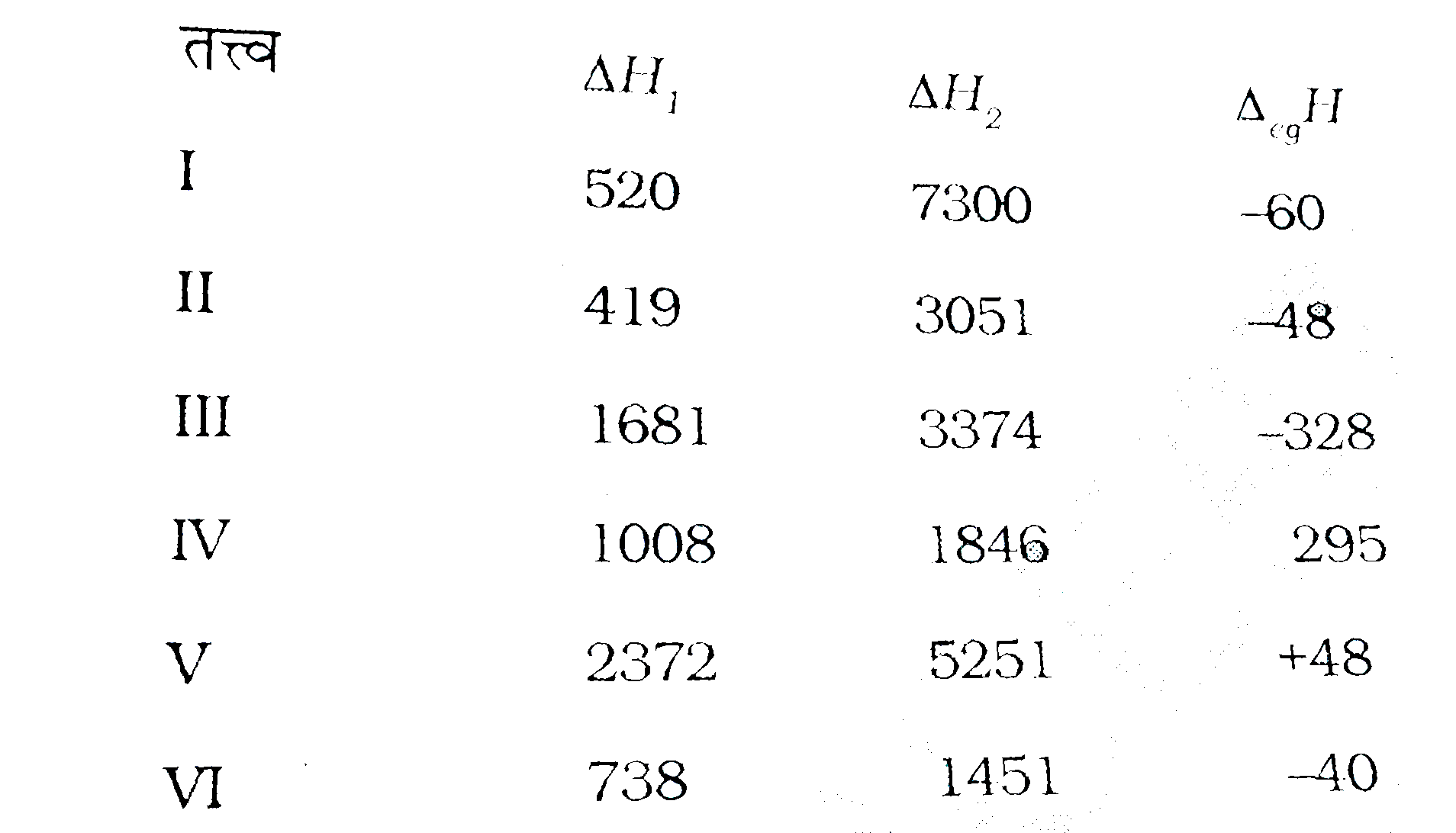
ऊपर दिए गए तत्वों में से कौन-सी
(क) सबसे कम अभिक्रियाशील धातु है ?
(ख) सबसे अधिक अभिक्रियाशील धातु है ?
(ग) सबसे अधिक अभिक्रियाशील अधातु है ?
(घ) सबसे कम अभिक्रियाशील अधातु है ?
(ड़) ऐसी धातु है, जो स्थायी द्विअंगी हैलाइड (binary halide), जिनका सूत्र (X = हैलोजन) है बनाता है |
(च) ऐसी धातु, जो मुख्यत: MX (X= हैलोजन) वाले स्थायी सहसंयोजी हैलाइड बनाती है |
View SolutionThe first (Delta_(i)H_(1)) and second (Delta_(i)H_(2)) ionisation enthalpies ("in" kJ mol^(-1)) and the (Delta_(eg)H^(ө)) electron gain enthalpy ("in" kJ mol^(-1)) of a few elements are given below: {:("Elements",(Delta_(i)H_(1)),(Delta_(i)H_(2)),Delta_(eg)H^(ө)),(I,520,7300,-60),(II,419,3051,-48),(III,1681,3374,-328),(IV,1008,1846,-295),(V,2372,5251,+48),(VI,738,1451,-40):} Which of the above elements is likely to be a. the least reactive element. b. the most reactive metal. c. the most reactive non-metal. d. the least reactive non-metal. e. the metal which can form a stable binary halide of the formula MX (X=halogen). f. the metal which can form a predominantly stable covalent halide of the formula MX(X=halogen).
View SolutionThe first and second ionisation enthalpies and the electron gain enthalpy of a few elements are given below:
Which of the above elements is likely to be
a. the least reactive element.
b. the most reactive metal.
c. the most reactive non-metal.
d. the least reactive non-metal.
e. the metal which can form a stable binary halide of the formula (X=halogen).
f. the metal which can form a predominantly stable covalent halide of the formula MX(X=halogen).
View SolutionThe first (Delta_(i)H_(1)) and the (Delta_(i)H_(2)) ionization enthalpy (in kJ mol^(-1) ) and the (Delta_(eg) H) electron gas enthalpy (in kJ mol^(-1) ) of a few elements are given below : {:("Element",,Delta_(i)H_(1),,Delta_(i)H_(2),,Delta_(eg)H),(I,,520,,7300,,-60),(II,,419,,3051,,-48),(III,,1681,,3374,,-328),(IV,,1008,,1846,,-295),(V,,2372,,5251,,+48),(VI,,738,,1451,,-40):} Which of the above element is likely to be : (a) the least reactive element ( b) the most reactive metal (c ) the most reactive non- metal ( d ) the least reactive non- metal ( e) metal which can form a stable binary halide of the formula MX_(2) ( x= halogen ) ? (f ) the metal which can form predominantly stable covalent halide of the formula MX ( X= halogen ) ?
View SolutionThe first and second ionization enthalpies and electron gain enthalpy of some elements are as given below: Which of these elements is the most reactive metal?
View SolutionThe first and second ionization enthalpies and electron gain enthalpy of some elements are as given below: Which of these elements is the most reactive metal?
View SolutionThe first and second ionization enthalpies and electron gain enthalpy of some elements are as given below:
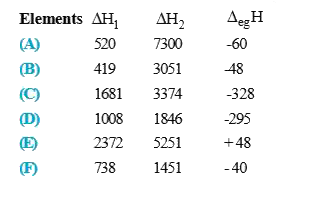
Which of these elements is the least reactive non-metal?
View SolutionThe first and second ionization enthalpies and electron gain enthalpy of some elements are as given below: Which of these elements is the least reactive non-metal?
View SolutionThe first and second ionization enthalpies and electron gain enthalpy of some elements are as given below:
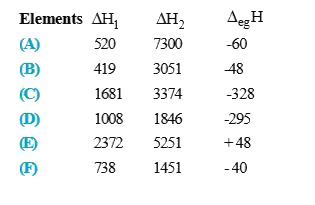
Which of these elements is the most reactive non-metal?
View SolutionThe first and second ionization enthalpies and electron gain enthalpy of some elements are as given below: Which of these elements is the most reactive non-metal?
View SolutionThe first IE and second IE (Kj mol^(-1)) and dalta_egH(kJ mol^(-1)) of a few elements are given below: Which of the above is likely to be the least reactive non-metal
View SolutionThe first and second ionisation enthalpies (in kJ ) and the electron gain enthalpy (in kJ ) of a few elements are given below:

The least reactive element is :
View SolutionThe first () and the second ionisation energies (kJ ) of a few elements are given below :

Which of the above elements is likely to be
a reactive non-metal?
View SolutionThe first ionisation energy and second ionisation energy (IE2) of elements X, Y and Z are given below.
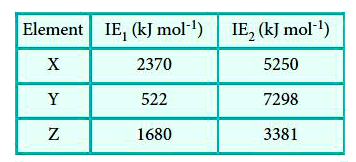
Which one of the above elements is the most reactive metal, the least reactive metal and a noble gas?
View SolutionMatch the correct ionisation enthalpies and electron gain enthalpies of the following elements {:(,,"Elements",,,,DeltaH_(1),,DeltaH_(2),,Delta_(eg)H),((i),,"Most reactive non metal",,A.,,419,,3051,,-48),((ii),,"Most reactive metal",,B.,,1681,,3374,,-328),((iii),,"Least reactive element ",,C.,,738,,1451,,-40),((iv),,"Metal forming binary halide " ,,D.,,2372,,5251,,+48):}
View SolutionThe first ionisation energy (IE_1) and second ionisation energy (IE_2) of elements X, Y and Z are given below. Which one of the above elements is the most reactive metal, the least reactive metal and a noble gas?
View SolutionThe first and second ionization enthalpies and electron gain enthalpy of some elements are as given below: Which of the elements given above is the least reactive?
View Solution